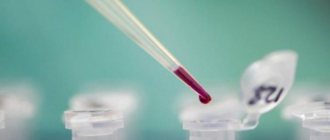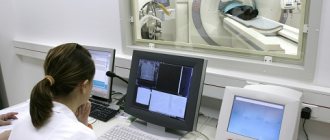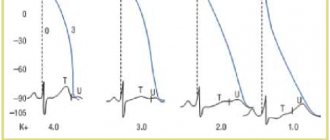What concepts are used when decoding
Decoding an ECG is a rather complex process that requires deep knowledge from a specialist. During the assessment of the heart condition, the cardiogram parameters are measured mathematically. In this case, concepts such as sinus rhythm, heart rate, electrical conductivity and electrical axis, pacemakers and some others are used. By assessing these indicators, the doctor can clearly determine some parameters of the functioning of the heart.
Heart rate
Heart rate is a specific number of heart beats over a certain period of time. Typically an interval of 60 seconds is taken. On a cardiogram, heart rate is determined by measuring the distance between the tallest teeth (R - R). The recording speed of the graphic curve is usually 100 mm/s. By multiplying the recording length of one mm by the duration of the segment R – R, the heart rate is calculated. In a healthy person, the heart rate should be 60 - 80 beats per minute.
Sinus rhythm
Another concept included in the interpretation of the ECG is the sinus rhythm of the heart. During normal functioning of the heart muscle, electrical impulses arise in a special node, then spread to the area of the ventricle and atrium. The presence of sinus rhythm indicates normal functioning of the heart.
The cardiogram of a healthy person should show the same distance between the R waves throughout the entire recording. A deviation of 10% is allowed. Such indicators indicate the absence of arrhythmia in a person.
Conduction Paths
This concept defines a process such as the propagation of electrical impulses through the tissues of the heart muscle. Normally, impulses are transmitted in a certain sequence. Violation of the order of their transfer from one pacemaker to another indicates organ dysfunction and the development of various blockades. These include sinoatrial, intraatrial, atrioventricular, intraventricular blocks, as well as Wolff-Parkinson-White syndrome.
On an ECG, a specialist can see a violation of cardiac conduction
Electrical axis of the heart
When deciphering a cardiogram of the heart, the concept of the electrical axis of the heart is taken into account. This term is widely used in cardiological practice. When interpreting an ECG, this concept allows a specialist to see what is happening in the heart. In other words, the electrical axis is the totality of all biological and electrical changes within an organ.
An electrocardiogram allows you to visualize what is happening in a specific area of the heart muscle using a graphic image obtained by transmitting impulses from electrodes to a special device.
The position of the electrical axis is determined by the doctor using special diagrams and tables or by comparing the QRS complexes, which are responsible for the process of excitation and contraction of the cardiac ventricles.
If ECG indicators indicate that the R wave in lead III has a smaller amplitude than in lead I, we are talking about a deviation of the cardiac axis to the left. If in lead III the R wave has a greater amplitude than in lead I, it is customary to speak of axis deviation to the right. Normal indicators in the cardiogram table are the highest R wave in lead II.
Teeth and intervals
On the cardiogram itself obtained during the study, the waves and intervals are not indicated. They are needed only for the specialist doing the decryption.
Prongs:
- P – determines the beginning of contraction of the atrium;
- Q, R, S – belong to the same type, coincide with the contraction of the ventricles;
- T – time of inactivity of the ventricles of the heart, that is, their relaxation;
- U - rarely noted on the cardiogram; there is no consensus on its origin.
For ease of interpretation, the cardiogram is divided into intervals. On the tape you can see straight lines that run clearly in the middle of the tooth. They are called isolines or segments. When making a diagnosis, indicators of the P – Q and S – T segments are usually taken into account.
In turn, one interval consists of segments and teeth. The length of the interval also helps assess the overall picture of heart function. The intervals P - Q and Q - T have diagnostic significance.
Important! You cannot read a cardiogram yourself without certain knowledge. Decoding of the cardiogram is carried out exclusively by a specialist.
Independent interpretation of ECG: algorithm of actions
Cardiogram analysis algorithms summarize practical experience and data taken from specialized literature. It is especially important to show how ECG interpretation is performed for students, interns, and paramedics who are starting their careers.
Sequence of actions when independently analyzing ECG results:
- Evaluate the rhythm and its regularity.
- The intensity of contractions of the heart muscle.
- The electrical axis of the heart or the frontal projection of the excitation vector of the ventricles and the direction of the electric wave along the ventricles during contraction are determined. The electrical axis of the heart is normal from 30° to 70°, direction down to right.
- The parameters of the P wave are determined.
- The QRS complex is analyzed.
- Determine the parameters of the ST segment.
- The characteristics of the T wave are analyzed.
- The characteristics of the remaining intervals and segments are analyzed.
Reading a cardiogram
How to decipher a cardiogram of the heart? This question is asked by many patients who have had to deal with the electrocardiography procedure. It is very difficult to do this yourself, because decrypting data has a lot of nuances. And if you read certain disturbances in the activity of the heart in your cardiogram, this does not at all mean the presence of this or that disease.
A cardiologist reads a cardiogram
Prongs
In addition to taking into account intervals and segments, it is important to monitor the height and duration of all teeth. If their fluctuations do not deviate from the norm, this indicates healthy functioning of the heart. If the amplitude is deviated, we are talking about pathological conditions.
Norm of waves on an ECG:
- P – should have a duration of no more than 0.11 s., a height within 2 mm. If these indicators are violated, the doctor can make a conclusion about a deviation from the norm;
- Q – should not be higher than a quarter of the R wave, wider than 0.04 s. Particular attention should be paid to this tooth; its deepening often indicates the development of myocardial infarction in a person. In some cases, tooth distortion occurs in people with severe obesity;
- R – when deciphered, it can be traced in leads V5 and V6, its height should not exceed 2.6 mV;
- S is a special tooth for which there are no clear requirements. Its depth depends on many factors, for example, weight, gender, age, body position of the patient, but when the tooth is too deep, we can talk about ventricular hypertrophy;
- T – must be at least a seventh of the R wave.
In some patients, after the T wave on the cardiogram, a U wave appears. This indicator is rarely taken into account when making a diagnosis and does not have any clear standards.
Segments and Intervals
Intervals and segments also have their own normal values. If these values are violated, the specialist usually gives a referral to the person for further research.
Normal indicators:
- The ST segment should normally be located directly on the isoline;
- The QRS complex should not last more than 0.07 - 0.11 s. If these indicators are violated, various pathologies of the heart are usually diagnosed;
- the PQ interval should last from 0.12 milliseconds to 0.21 seconds;
- The QT interval is calculated taking into account the heart rate of a particular patient.
Segments and Intervals
Important! The ST segment in leads V1 and V2 sometimes runs slightly above the baseline. The specialist must take this feature into account when deciphering the ECG.
Electrocardiogram indicators
- A small P wave representing atrial contraction.
- The QRS complex, which corresponds to the contraction of the ventricles.
- The ST interval with the T wave, which follows the ventricular complex and represents the moment of ventricular relaxation.
Each contraction of the atria must be followed by a contraction of the ventricles - the main law of heart rhythm. This means that after each P wave there is a QRS complex.
Most often, two types of changes occur on the ECG: disturbances in heart rhythm (arrhythmia) or disturbances in the blood supply to the myocardium (ischemia).
In the first part of our article we will talk about arrhythmias.
Decryption features
To record a cardiogram, special sensors are attached to a person’s body, which transmit electrical impulses to an electrocardiograph. In medical practice, these impulses and the paths they take are called leads. Basically, 6 main leads are used during the study. They are designated by the letters V from 1 to 6.
The following rules for deciphering a cardiogram can be distinguished:
- In lead I, II or III, you need to determine the location of the highest region of the R wave, and then measure the gap between the next two waves. This number should be divided by two. This will help determine the regularity of your heart rate. If the gap between the R waves is the same, this indicates normal contraction of the heart.
- After this, you need to measure each tooth and interval. Their standards are described in the article above.
Most modern devices automatically measure your heart rate. When using older models, this has to be done manually. It is important to consider that the ECG recording speed is usually 25 – 50 mm/s.
Heart rate is calculated using a special formula. At an ECG recording speed of 25 mm per second, it is necessary to multiply the R - R interval distance by 0.04. In this case, the interval is indicated in millimeters.
At a speed of 50 mm per second, the R - R interval must be multiplied by 0.02.
For ECG analysis, 6 of 12 leads are usually used, since the next 6 duplicate the previous ones.
Study frequency
When conducting an ECG, sensors that are attached to the chest do not have any harmful effects on the body. The sole task of these sensors is to capture and transmit cardiac impulses. Thus, an ECG does not cause any harm to the human body, even if the study is performed daily.
Doctors believe that the following frequency of ECG is justified:
- healthy population under 40 years of age can conduct the study once a year;
- people with chronic diseases and patients suffering from cardiovascular diseases - the ECG schedule is determined by the attending physician, as a rule, once a quarter;
- workers associated with risk, for example, the Ministry of Emergency Situations, etc. doctors advise having an ECG every six months;
- people who have crossed the forty-year mark should undergo a heart examination every 3-6 months, the frequency depends on the state of health and will be determined only by a doctor.
Normal values in children and adults
In medical practice, there is the concept of an electrocardiogram norm, which is typical for each age group. Due to the anatomical characteristics of the body in newborns, children and adults, the study indicators are slightly different. Let's take a closer look at them.
ECG norms for adults can be seen in the figure.
Normal ECG in adult patients
A child's body is different from an adult's. Due to the fact that the organs and systems of the newborn are not fully formed, electrocardiography data may differ.
In children, the mass of the right ventricle of the heart prevails over the left ventricle. Newborns often have a high R wave in lead III and a deep S wave in lead I.
The ratio of the P wave to the R wave in adults is normally 1:8; in children, the P wave is tall, often more pointed, in relation to R is 1:3.
Due to the fact that the height of the R wave is directly related to the volume of the ventricles of the heart, its height is lower than in adults.
Financial conditions
All lessons in the section “Textbook - simulator”, “Examples of cardiograms” are available freely. Exercises for the first 15 lessons in the “Textbook - Simulator” are also available freely (only authorization is required).
Starting from section 16 (“sinus tachycardia”), exercises are available for a fee. The cost of access to all sections is 10 rubles per day (for 24 hours). You can choose any number of days of access to paid sections. To transfer money, go to the "Payment" section.
What affects the accuracy of indicators
Sometimes the results of a cardiogram may be erroneous and differ from previous studies. Errors in results are often associated with many factors. These include:
- incorrectly attached electrodes. If the sensors are poorly attached or become dislodged during an ECG, the test results can be seriously affected. That is why the patient is recommended to lie still during the entire period of taking the electrocardiogram;
- extraneous background. The accuracy of the results is often influenced by extraneous devices in the room, especially when the ECG is performed at home using mobile equipment;
- smoking, drinking alcohol. These factors affect blood circulation, thereby changing the cardiogram parameters;
- meal. Another reason that affects blood circulation and, accordingly, the correctness of indicators;
- emotional experiences. If the patient is worried during the study, this may affect the heart rate and other indicators;
- Times of Day. When conducting a study at different times of the day, the indicators may also differ.
The specialist must take into account the above-described nuances when interpreting the ECG; if possible, they should be excluded.
So which study is better: ECG or ultrasound of the heart?
Ultrasound and ECG are two diagnostic methods that are used in cardiology to diagnose problems in the functioning of the heart muscle. Based on the results, the specialist assesses the degree of damage to the organ and selects the most appropriate treatment method.
The data obtained from both studies have equally high information content, but the results of the ultrasound examination provide a more meaningful picture. That is why, before conducting any examination, you should visit a cardiologist, who, based on the patient’s complaints, will be able to determine the most appropriate examination method. In most cases, an ECG is considered the primary procedure, because it allows you to get a general picture of the condition of the heart muscle. If the cardiologist does not like the resulting picture, then he can prescribe a more accurate procedure, namely an ultrasound.
Both methods are independent of each other and it is not possible to determine which one is better, because both of them must be completed periodically if there are complaints about the work of the body. Thus, timely detection of heart disease will help to avoid more serious consequences.
Dangerous diagnoses
Diagnostics using electrical cardiography helps to identify many cardiac pathologies in a patient. Among them are arrhythmia, bradycardia, tachycardia and others.
Cardiac conduction disorder
Normally, the electrical impulse of the heart passes through the sinus node, but sometimes a person has other pacemakers. In this case, symptoms may be completely absent. Sometimes conduction disturbances are accompanied by rapid fatigue, dizziness, weakness, surges in blood pressure and other symptoms.
Cardiac conduction abnormalities on ECG
In asymptomatic cases, special therapy is often not required, but the patient should undergo regular examinations. Many factors can negatively affect the functioning of the heart, which entails disruption of depolarization processes, decreased myocardial nutrition, development of tumors and other complications.
Bradycardia
A common type of arrhythmia is bradycardia. The condition is accompanied by a decrease in heart rate below normal (less than 60 beats per minute). Sometimes such a rhythm is considered normal, which depends on the individual characteristics of the body, but more often bradycardia indicates the development of one or another heart pathology.
Features of the ECG in a patient with bradycardia can be seen in the figure.
Bradycardia on the cardiogram
There are several types of disease. For latent bradycardia without obvious clinical signs, therapy is usually not required. In patients with severe symptoms, the underlying pathology causing the heart rhythm disturbance is treated.
Extrasystole
Extrasystole is a condition accompanied by untimely contraction of the heart. In the patient, extrasystole causes a sensation of a strong cardiac impulse, a sensation of cardiac arrest. At the same time, the patient experiences fear, anxiety, and panic. The prolonged course of this condition often leads to impaired blood flow, entailing angina pectoris, fainting, paresis and other dangerous symptoms.
It is believed that with extrasystole no more than 5 times per hour there is no danger to health, but if attacks occur more often, appropriate treatment should be carried out.
Sinus arrhythmia
The peculiarity of this disorder is that when the heart rate changes, the work of the organ remains coordinated, the sequence of contractions of the heart parts remains normal. Sometimes, in a healthy person, sinus arrhythmia can be observed on an ECG under the influence of factors such as food intake, anxiety, and physical activity. In this case, the patient does not experience any symptoms. Arrhythmia is considered physiological.
In other situations, this disorder may indicate pathologies such as coronary heart disease, myocardial infarction, myocarditis, cardiomyopathy, and heart failure.
Patients may notice symptoms in the form of headaches, dizziness, nausea, heart rhythm disturbances, shortness of breath, and chronic fatigue. Treatment of sinus arrhythmia involves getting rid of the underlying pathology.
Norm and signs of arrhythmia on a cardiogram
Important! In children, sinus arrhythmia often occurs during adolescence and may be associated with hormonal imbalances.
Tachycardia
With tachycardia, the patient experiences an increase in heart rate, that is, more than 90 beats per minute. Normally, tachycardia develops in people after intense physical exertion; sometimes stress can cause palpitations. In a normal state, the rhythm is normalized without consequences for health.
It is important to note that tachycardia is not an independent disease and does not occur on its own. This disorder always acts as a secondary symptom of some pathology. This means that treatment should be aimed at the disease causing the increased heart rate.
How the study of electrocardiography is structured on the site
In the “Textbook - simulator” section, educational topics on electrocardiography are posted in the form of lessons. At the end of each lesson there is a transition to exercises on this topic.
Familiarize yourself with the lesson content and get a general idea of the topic. Don't try to remember all the details right away. It will be more convenient to do this when further performing step-by-step exercises for the lesson.
Exercises are the main part of the teaching methodology on this site.
Perform consistently all the tasks that are offered after each lesson and in the control and repetition sections. This way you will be able to master the necessary knowledge and practical skills in electrocardiography in detail and without intense memorization.
Try it and decide if it's right for you.
The results of the exercises are saved in the database. This allows the site's computer program to evaluate your level on each academic topic. You can see the results of these assessments on the personal statistics page. Depending on how you perform the suggested training tasks, the statistics change accordingly.
Based on this data, the program determines which exercises to offer you and what additional information and explanations to provide you in a timely manner. This feedback tailors the learning to you.
The same exercise may be offered to you more than once during your work. Please complete all the tasks (and there should be many) patiently, as this will help you retain the information well and develop practical skills.
When starting the exercises, you need to log in (log in with your username and password) so that you can save information about the tasks you have completed in the database.
In addition to the “Textbook - simulator” section, read and regularly review the ECG in the “Examples of cardiograms” section.
For use in lesson texts, exercises and in the “Examples of cardiograms” section, the website has collected more than 1000 electrocardiograms from various sources. After each illustration there is a link to the source from which the example was taken.








